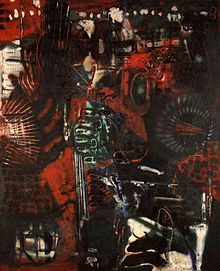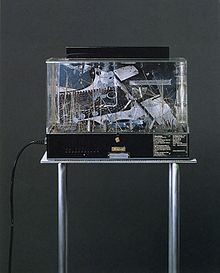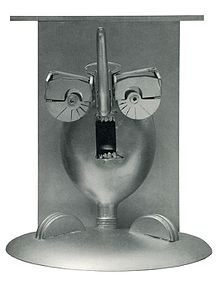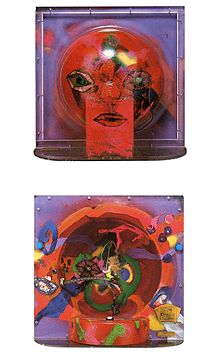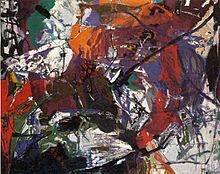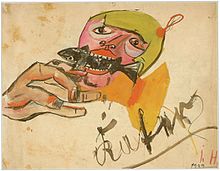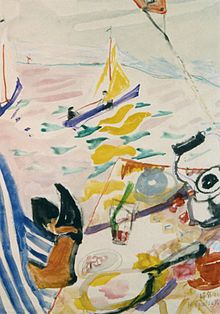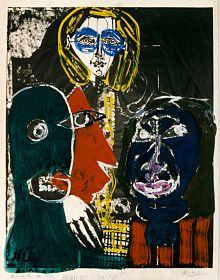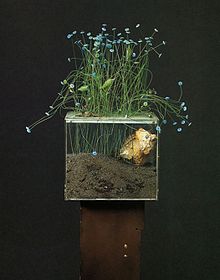Irma Hünerfauth
Irma Hünerfauth (born December 31, 1907 in Donaueschingen ; † December 11, 1998 in Kreuth ) was a German painter , sculptor and object artist .
Life
Irma Hünerfauth was born as the daughter of the brewery manager Hünerfauth on December 31, 1907 in Donaueschingen. In 1914 the family moved to Munich after a major fire. In 1917 Irma Hünerfauth attended a drawing course for adults. In 1923, while she was still at school, she did a traineeship in window dressing in a fashion store. 1925–1928 she attended the women's labor school, from 1929 to 1931 the Blocherer School of Design in Munich and from 1931–1932 the arts and crafts school in Munich as a student of Helmuth Ehmcke. In 1933 she married the lawyer Wilhelm Schäfer, with whom she had a son. 1935–1937 she studied painting with Professors Jank and Hess at the Academy of Fine Arts in Munich . In 1938 she divorced Schäfer and retired to Dachauer Moos. In 1939 she married her second husband Jost Höpker, "but since the marriage was a mistake, I filed for divorce very soon".
In 1940 she returned to her parents in Großhesselohe near Munich. In 1942 they were evacuated first to the Chiemsee and then to the vicinity of Landshut. In 1945 they returned to Großhesselohe. Hünerfauth built a studio there. On November 20, 1948, she married her third husband, Franz Führer (who called himself “Führer-Wolkenstein” as an artist), and lived happily with him for 28 years. He was the construction director at the Munich public utilities. Führer-Wolkenstein helped her with the electrotechnical details of her multimedia works of art and worked closely with her. After his retirement he created his own kinetic works of art, so-called recycling machines.
In 1954, Hünerfauth took six months' lessons from the informal painter Conrad Westpfahl (1891–1976), who introduced her to abstract painting .
In 1958 she took courses in etching and lithography . In 1959 she received the Prix d'Unions des Femmes Peintres in Paris for her picture entitled "Düsternis". Two artists (Lentz and Strauss) showed their displeasure and the picture was apparently pierced by one of these artists with a large knife, Hünerfauth had it restored. The art critic Franz Roh (1890–1965) and his wife Juliane Roh were among the early patrons and patrons of Hünerfauths. Both made positive comments about their work in their art reviews. Hünerfauth was deeply affected by Roh's death and put a raw folder in memory of him.
In 1962 she took part in a welding course. As a result, her first metal sculptures were made from scrap, as if scrap objects were a matter of course in the art of the sixties and seventies. In 1964 she received the advancement award of the autumn salon in Munich.
In 1965 she founded Group K in Munich together with Walter Raum (1923–2009), Dieter Stöver (1924–1988) and Hans Joachim Strauch. In 1966 she received the Medal de Bronze de la Ville de Paris.
In 1968/69 she finally turned away from painting. The first objects of the group "K" were created in the Haus der Kunst (optical-acoustic collage for piano and loudspeaker) and from 1971 she and her husband developed vibrating objects.
From 1972 "talking boxes" were created on the subjects of "loneliness", "first love" and "war". All of these objects required a lot of technical tinkering. Führer-Wolkenstein, who among other things had invented an earthing contact test device, was the ideal partner for an artistic collaboration. He was deliberate, deliberate and intense, while she was very spontaneous and showed aggressive, hands-on determination. Both complemented each other in their temperament. On November 25, 1976, Führer-Wolkenstein died and Hünerfauth erected a grave monument (scrap grave) welded together from scrap pieces for him in the cemetery in Pullach. Since her husband's technical sophistication proved to be irreplaceable, Hünerfauth specialized in so-called “artist prayer books” in the 80s and 90s, which she put together from microelectronic scrap. The use of these materials as well as the construction of the so-called “speaking boxes” was unique and set them apart from other object artists of the time.
In 1990 Hünerfauth received the Schwabing Art Prize in Munich. She died on November 12, 1998 in Kreuth (Tegernsee).
plant
Hünerfauth began her artistic development with representational painting. Even in her early works she showed a lot of originality, bold, unexpected perspectives and unusual colors. The art critic Franz Roh judged that stylistically she had not opted unilaterally for a painterly Tachism nor for a graphically linear constructivism , but stood between the two camps. Her painting style is a "highly individual cross between calm and movement in the picture". She sought to transcend the conventional by experimenting with unusual tools. For example, she worked with a dentist's drill on a series of drypoint etchings.
She came to abstract painting through her teacher Conrad Westpfahl, an important exponent of informal art. She expanded her mixed technique with collages and applications made from different materials. Then she started tinkering and building and from then on worked exclusively in three-dimensional space. With the objects subsequently created (scrap sculptures, assemblages, etc.), her work also connects with the Nouveaux Realistes. This group of artists includes u. a. Niki de Saint Phalle, Jean Tinguely, Arman and also Daniel Spoerri.
Hünerfauth named her art with the word creation IRMAnipulations. This term was coined in 1983 on the occasion of an exhibition at the Goethe-Institut in London and retained by the artist as a kind of trademark. One of the most important exhibitions of the entire oeuvre took place from August 3 to September 2, 1990 in the Rathaushalle in Munich, with the title “Irma Hünerfauth - IRMAnipulations”.
painting
In the multi-layered oeuvre of the artist, her paintings also play an important role. Irma Hünerfauth's artistic development begins with painting. She learned the trade with a solid education under Professors Jank and Hess at the Academy of Fine Arts in Munich. Hünerfauth initially painted representationally, both landscapes (e.g. Isartalbahnhof, 1938) and portraits, mostly from family surroundings (e.g. Hünerfauth family, 1946) and if she had followed this path, she would have been a good painter with them late impressionist lettering. But even the works of her early work reveal her own signature in the style of painting. Occasionally one can also find expressionist elements, such as B. the wildly moving landscape formations in the painting “Pupplinger Au” (1950) or “Mother and Son” (1952), which give an idea of spiritual movement and depth, similar to z. B. in the famous painting “The Scream” by Edvard Munch (1892). From 1954 she began to paint abstractly under the influence of Conrad Westpfahl. One of her last figurative pictures "Winter im Gries" (1958) already completely dispensed with perspective and stylized the buildings into abstract surfaces. Now she wanted to strip off the decorative entirely. The following painterly work by the artist can be described as both consistent and radical. She tried out all of the contemporary trends that were essential to her. She “seeks to transfer the inventive impulse into a balance that has a meditative character. The hardness of the setting and the gentleness of the whole gain the playing power of a dialogue. The dialogue moves and facets the surface that appears to be traversed by a kind of dream ”. Then again she lived out the soul on the canvas with a chaotic jumble of brushstrokes and an overwhelming intoxication of colors. B. in the mixed media "Untitled" (1963). Sometimes these mostly large-format works are reminiscent of the pioneers of action painting , such as Jackson Pollock (1912–1956), Joan Mitchell (1925–1992), Grace Hartigan (1922–2008) or Helen Frankenthaler (1928–2011). At first it was playful as in the painting “16.1.1963” (1963), then experimentally, for example. B. in the painting “Die Rote Schmach” (1966) by fixing metal wires through the canvas like a collage. Her abstract painting combines mental expressivity with graphic rigorism. Then, at the end of the sixties, the artist turned away from painting, incomprehensibly and completely unexpectedly for many, and thus left behind only a relatively small painterly oeuvre (Wilhelm Schäfer only lists 45 paintings in the estate).
In 1969 she painted the “last picture” (1969/1989). It shows a painted, perforated metal plate on which, as if driven by electronic power, emotional impulses let off steam. In the right corner one discovers a collage-like drain plug with a chain, a find that, just as unreal as the motif that appears somewhere between space and earth, profanely ironizes the entire utopian, playful-futuristic representation. It is realized playfully, idiosyncratically, sometimes curiously and also visionary on the screen. Nevertheless, the surface, even that of a large screen, has probably become too small as a playing field. The first sculptural works were already being made and she probably wanted to concentrate on one form of expression, ultimately it is work in three-dimensional space. Perhaps she was also looking for a way to escape the isolation of painting and to find more direct contact with the audience through plastic art. On the other hand, the turning away from painting was symptomatic of the end of the sixties for other artists and Hünerfauth wanted to experiment, just as artists of their own kind did at that time.
In sketches for her sculptural work and also later, she partially returned to representational painting. B. in the picture “Mother on the way to the primal mother” (1981).
Graphics
The development of her graphic work took place parallel to her painterly work and ultimately also became experimental. In his early work, Hünerfauth made representational drawings and graphically executed watercolors in the style of academic tradition. But even here the sketchy works sometimes have an expressive verve. The graphic works created from 1958 onwards have already been detached from this and are no longer representational. She worked on plates for drypoint etchings with a dentist's drill, for example. Linocuts, lithographs and etchings were created, these sheets were usually only printed in very small editions, the embossed prints were only made as unique pieces. These applied embossed prints are to be emphasized, also scrap embossed prints to which she attached metal or pieces of fabric, as well as her Picasso variations. They are posters or Picasso reproductions painted over by the artist. These were inspired by the “Painting Picasso” campaign by the Engelhorn Foundation, Grünwald / Munich and as an ironic answer, as the gallery owner Peter Lufft often equated their intentions with those of Picasso.
The already mentioned raw cycle deserves to be particularly emphasized as a homage that includes friendship, closeness, death and thus deep personal emotions.
Work
Personal exhibition catalogs / artist diaries
The artist began to design exhibition catalogs by hand in 1978, a work show in the manner of an artist's diary, with collage-like pasting of excerpts from exhibition brochures, press reports, etc. a., each approx. 50 sheets / pages (format approx. 20 × 23 cm), which she fixed with two sturdy brass screws. The exact edition is not known. These artist diaries are related to the so-called Fluxus books and can therefore also be viewed as independent works.
Talking boxes and objects
The first so-called glass “talking boxes” were created in 1972, these are unique in their kind and cannot be found in other object artists of the time. In the boxes there are various objects, technical junk, which can be moved by a motor or commented acoustically on a tape at the push of a button. The artist developed her own instructions for use for these objects:
"The game begins. Reach into the sound screen and pull the ball down several times. At the same time, you observe how things in the box sway gently, according to their natural oscillation, as soon as a gust of wind gently moves nature. Breathe deeply, keep playing with the bead, listen, connect with your thoughts, take the freedom to dream, forget about your everyday life. Break away from the 'correctness' of society, break away from the 'correctness' of criticism, break away from the 'correctness' of science. They are overrated correctnesses. Breathe deeply, play yourself freely, just be yourself. "
With these objects, Irma Hünerfauth depicts human, ideological thoughts and events: the misery of the war and the phenomena that accompany it, the loneliness that the mass housing silos and building blocks of our satellite cities create ("eyes staring into space from countless windows"). It shows the death of Andermann and the blue pistol made by children. Yes, it shows the whole dance of our life: trembling grass and first love, demonstrations (Der Occammensch) and natural idyll, philosophy and comedy (glass button trees) A striking example of these talking boxes is the "Blue Pistol" box made in 1973. It is included Industrial scrap filled. From its endless tape you can hear the artist's voice reciting a text by Meta Kristall: “Blue pistol full of lust used by boys' hands, now rotting as scrap in the landscape, a butterfly sways on it. Sharp shots fall in the Sunday peace, like chocolates in the mouths of the affluent society, maneuver exercise says a man has a promising future ".
Another box made in 1983 is made of Plexiglas with a collaged back wall. The tape with the voice of Irma Hünerfauth warns with music and text by Meta Kristall: “War! Your voice is the death of Andermann, man you shoot at Andermann ... Andermann shoot ... "Shots are fired, Meta Kristall screams:" Dead! dead! Stop killing! Are you talking to Andermann ... Andermann is talking to you ... "
Special attention should be paid to the Pop Art- related objects "Emanze" (1990) and "War - also animals suffer" (1986) and the spatial installation "Rockers Tod" (1986), designed on the front and back and painted in bright colors. 1989).
The painter and gallery owner Peter Luft (1911–1997) sees many similarities between Hünerfauth's artistic creative drive and Picasso's. Her art resembles Picasso's in her spirit, her wit, her irony, her simplicity, her persuasiveness and her volatility. However, Lufft is of the opinion that the artist transcends Picasso's stylistic devices with the complexity of her speaking boxes:
“The circle of her design is sometimes, I feel, related to that of Picasso. Certainly the shape is different; and also the means. While Picasso remains a painter and draftsman in the vast majority of his works, i.e. a designer in the surface, Irma Hünerfauth stepped out of two-dimensionality, never to return to it. She works three-dimensionally, in space, plastic, drives, starting from the graphic, frottage, starting from the plastic, ferro-montage, loves like Picasso ready mades , like Picasso Combine painting , like Picasso material pictures , but beyond that she loves and practices them: Contre reliefs, machine art , found object and especially bruitism , that is, the mixed-media synthesis of sound, literature, kinetics and as theatrical staging. With such presentations she also leaves Picasso far behind. "
Kinetic vibrating objects
From 1970 she developed so-called vibration objects. These are wires, buttons, cartridges; Electrical switching parts and other found objects that start playing spherical music at the push of a button. This interactive dynamic makes it easier for art lovers to access their poetic concept. Nevertheless it is clear to her: “That my work will be difficult to access to a mass society.” Only the initiate suspects that the vibrating object traces the path of art from the divine aesthetics of the beautiful to the reflection of a disintegrating, disparate godless world. “With these vibrating objects, the 'fine, precious, like a jeweler' - these are her words - should be shaken. The viewer is confronted as a composition falls apart. He is supposed to make even the fine compositional elements tremble and clink by touching them, he is supposed to experience the 'discomfort of the destruction of the beautiful as an awareness.' "
Ferromontages, metal collages / assemblages
Hünerfauth showed enormous originality with her ferromontages, with which she broke into the predominantly male domain of junk plastic. These are plastics assembled from affluent garbage and scrap, from chrome-nickel-plated automobile parts, bumpers, radiator hoods, steel ribs, steel lamellas, large threads, pipes, ball bearings and the like. There are high-gloss structures, head-high figures and designs that she screwed or welded together with the help of her husband. These works of art are reminiscent of religious cult objects in an ironic form. Initially - at the end of the 1960s - there were still smaller bronze sculptures that she presented on plinths or small tables. "Readymades" are also among them. Then the figures get higher and higher: the "iron or sunflower" (made from agricultural machine parts), "portrait of JWK" on a man-high column (fluted), "serpentine", "portrait of Frau Heller"; particularly impressive: “Instance” (1977), “Schwarzer Falter” and the warning “Ma (h) nuel”. These were all free-standing, round sculptural objects.
Probably the most important of these ferromontages bears the title "Occam-Mensch", taken from the press, and can be described as her main work. The two-meter-high sculpture with a gas mask, open lungs and many symbolic exhaust pipes was created in 1971 from unchanged machine parts and was first publicly exhibited by the artist in the same year in Occamstrasse in Munich / Schwabing. At the time it was depicted in the newspapers as "Occammensch" and sometimes mocked, in 1990 it was again shown publicly at the Gasteig in Munich / Haidhausen, loved and appreciated by the public and printed as a poster. This object calls for climate protection and uses the play on words "STATT AIR - CITY AIR" to draw attention to environmental pollution or carbon dioxide pollution in large cities. An artistically unique, admonishing and socially critical ironic work of art. The work, which is described as “not for sale”, accompanied the artist for decades and was revised by her several times.
But there were also relief-like, more two-dimensional works. These are metal plates measuring one by two meters, which she designed with scrap and found objects, so-called metal collages (assemblages). The artist temporarily attached some of these metal collages (assemblages) to the outer facade of her house in order to expose the objects to the weather or natural corrosion. The artist described the material used as "too beautiful scrap". Her idols and "idols" are also noteworthy, especially those "Götzin mit Klingelbusen", a metal-mounted female bust in which the nipples are formed by push-in metal bell buttons. A verse by Johann Wolfgang von Goethe is affixed to the base: “The girl's breasts in the hand, the front door bell on the wall, are male related. Because both indicate that there is someone downstairs, outside, who is pleading for admission. "
Artist prayer books made from microelectronic scrap
After the death of her husband, she limited herself to smaller, easier-to-design objects. She made "artist's prayer books" or in English "The Artist's Prayer Books" as she calls them, which now occupied all of her imaginative work. In the manner of a goldsmith's artist, the fine and precious are determined and processed in leporello-like panels and leporello-containing wooden albums into treasures, scrap delicacies. Here they turned into microelectronics scrap, waste from computer hardware, electrical conductors, and fine control panels. They are small metal collages (assemblages). Compared to other artists such as B. Miguel Berrocal , Lee Bontecou , Pol Bury , Yves Klein , Norbert Kricke , Louise Nevelson , Robert Rauschenberg , Betye Saar , Kurt Schwitters , Tatlin , Tinguely and Vosswinkel, their use of this material must be regarded as unique. They are now objects of “silence” again. Even the smaller, in the truest sense of the word “more manageable” formats, not only allow, but actually force a more detailed examination and examination of the formal, graphic, colored and material means and possibilities and the intentions of the artist. Something meditative moves into her production and her artistic design and prompts the viewer to adopt a behavior that she had already wished for when looking at her very early non-representational drawings and paintings, when in January 1960 she said to her viewer: “Get on into the picture by scanning the picture with your eyes, the lines will guide you. I wish the viewer that in dialogue with the work of art he succeeds in stepping out of himself, to a new self-discovery in another sphere of consciousness. "
The name “The Artist's Prayer Books” already suggests that these artistic miniatures are also works that (like all art by Irma Hünerfauth) are to be understood as ambiguous and provocative. The term alludes to a type of text that was conceived in the 19th century especially for women for an intimate turn to God. The books were particularly beautifully executed and were intended to represent piety in public. The apparent craftsmanship is still reminiscent of the original meaning, the praise of God, but the execution is absolutely individual. Hünerfauth had a dialogue with himself and with the expectations of the audience. The material (scrap) also evokes thoughtfulness. Questions like: is the computer the new god, or the individual? For those who still don't understand, she added a motto to every artist's prayer book: “Don't think, be amazed!” “The creative power in the prayer books is so great that the material, the application, as it were transformed into a single matter, which is inspired by personal intuition, which has the same structure as, for example, its more relief-like 'idols.' "
Irma Hünerfauth, whose works were mostly sold directly to private and public collections and who therefore rarely appeared in the international art scene and in the auction market during her lifetime, is not only one of the notable artists of post-war modernism, but also counts with her early work to the artists of the so-called "lost generation". A generation of artists wrongly forgotten because of the historical constellation of the early 20th century. The rediscovery of the artist now enables a new perspective on her entire artistic work.
Comparable working artists of this era are u. a .: Hannelore Baron (1926–1987), Mary Bauermeister (b.1934), Lynda Benglis (b.1941), Lee Bontecou (b.1931), Louise Bourgeois (1911–2010), Feliza Bursztyn (1933–1982) , Rosemarie Castoro (1939–2015), Barbara Chase-Riboud (b. 1939), Jay DeFeo (1929–1989), Dorothy Dehner (1901–1994), Claire Falkenstein (1908–1997), Helen Frankenthaler (1928–2011) , Gertrud Goldschmidt (1912–1994), Elsa Gramcko (1925–1994), Gertrude Greene (1904–1956), Nancy Grossman (b.1940), Grace Hartigan (1922–2008), Eva Hesse (1936–1970), Lee Krasner (1908–1984), Alice Trumbull Mason (1904–1971), Joan Mitchell (1925–1992), Louise Nevelson (1900–1988), Pat Passlof (1928–2011), Beverly Pepper (b. 1922), Betye Saar (b.1926), Carolee Schneemann (1939–2019), Janet Sobel (1894–1968), Nancy Spero (1927–2009), Hedda Sterne (1910–2011), Dorothea Tanning (1910–2012).
Since March 2018 the artist has been represented with two large-format paintings in the permanent museum presentation of the Städtische Galerie im Lenbachhaus in Munich. The collection presentation “I'm a Believer. Pop Art and Contemporary Art from the Lenbachhaus and the KiCo Foundation “shows the two paintings by Irma Hünerfauth in two newly furnished rooms, together with works by Günter Fruhtrunk and Rupprecht Geiger, as a supplement to important positions in Munich painting in the 1950s and 60s.
In an international comparison, the work of Irma Hünerfauth was posthumously with her speaking box "First Love" from April 12 to July 28, 2019 in the group exhibition with prominent figures: "Straying from the Line", in the Schinkel Pavilion Berlin , which shows important positions in feminist art the last hundred years showed. Including the rediscovery of the unjustly forgotten artists and pioneers such as Lee Lozano, Irma Hünerfauth and Betye Saar.
literature
- H. Vollmer, Allgemeines Künstlerlexikon, Vol. 6, p. 83, Leipzig, 1953–1962
- Roh, Juliane, An exhibition of little-known Munich painters, February 13th - March 15th, 1959, Society of Friends of Young Art, Munich, 1959
- Roh, Franz, On the painting of Irma Hünerfauth, in: The art and the beautiful home 58, pp. 365–367, Munich, 1960
- Pellex, Georges, in: Das Werk, Winterthur M / 1960
- Lexicon of Munich celebrities, VDM Verlag, Munich, 1962
- Roh, Franz, German painting from 1900 to today, The Art and the Beautiful Home, Munich, 1962
- Roh, Juliane, in: The artwork 7 / XIV, 1963
- Scott, John, Abstract Artistry, in: Building Industry News, London, 1963
- Mazenod, D. Artistes Contemporains, Paris, 1964
- Schindler, Ottheinrich, Neue deutsche Graphik, Frankenthal, 1965
- Roh, Juliane, in: Bogawus, Münste, r 1966
- Graphic Society Annual, New York, 1968
- Niggl, Thomas, d'Orville, Christian, Prem, Heimrad (ed.), Omnibus News, Munich, 1968
- Römer Pelizaeus Museum (ed.), Kinetic art objects, Hildesheim, 1968
- Roh, Juliane, in: The artwork 22: 1968/69 (9/10), p. 82
- Galerie Walter Koch, Munich, 1977
- Röthel, Hans Konrad, Hünerfauth - Wolkenstein, exhibition catalog, 1977
- Roh, Juliane, Hünerfauth - Wolkenstein, in: The artwork 6/1977
- Irma Hünerfauth “Ulm Theater. 12.10.-15.11.1980. “Exhibition catalog. Buildings made of metal and junk, with numerous illustrations, 1980
- Evers, Ulrika, Lexicon of German Women Artists of the 20th Century, Hamburg, 1983
- Götze, Gerhard, The kinetic artist, in: Munich Mosaik, May / June 1988
- Irma Hünerfauth. IRMAnipulations; Exhibition catalog; Munich Town Hall Hall. With contributions by Irma Hünerfauth, Peter Lufft and Christoph Wiedemann. Publisher Antje Kunstmann, Munich, 1990
- Informal and expressive-abstract graphics from the 50s and 60s (catalog Pfalz-Galerie), Kaiserslautern, 1993
- Ottomeyer, H. / Digit, A., Furniture of Neoclassicism and New Objectivity (Catalog City Museum), Munich, 1993
- Netta, I. (arr.), Memory opens its gates. Contemporary art in the Lenbachhaus Munich (catalog) Ostfildern-Ruit, 1999
- Buhlmann, BE (editor), three-dimensional works owned by the Pfalz-Galerie Kaiserslautern (catalog), Kaiserslautern, 2000
- Dollen, Ingrid von der. Female painters in the 20th century, visual art of the "lost generation", Hirmer Verlag, Munich, 2000.
- Partsch, S .: Hünerfauth. In: Allgemeines Künstlerlexikon, Vol. 75, De Gruyter Saur, Berlin, 2012–2013.
- Schinkel Pavillon Berlin "Straying from the Line" exhibition catalog, April 2019
Exhibitions
- 1946 Kammerspiele, Munich
- 1947 BBK, Munich; Gedok, Unesco building, Beirut, Lebanon
- 1959 Joy of Young Art, Kunstverein, Munich; Palais des Beaux-Arts, Paris, France; Traveling exhibition 'Modern Graphics', Frankenthal
- 1959–61 Large art exhibition, Neue Gruppe, Haus der Kunst, Munich
- 1961 Solo exhibition: Städtische Galerie im Lenbachhaus , Munich; New Darmstadt Secession, Darmstadt; Nouvelle école européenne, Hessenhuis, Antwerp, Belgium; Four German artists, Royal Scottish Academy, Edinburgh, England; Gedok, Rome, Italy; Fachoberschule, Munich
- 1962 State Collection of Graphics, Munich; Gedok, Art in Architecture, City Museum, Munich; Solo exhibition: Galerie Kasper, Lausanne, Switzerland
- 1962/63 traveling exhibition 'Moderne Graphik', Frankenthal
- 1962–65 Friends of Young Art, Kunstverein, Munich
- 1963 Women's Biennial, Paris, France; Boarding school Watercolor exhibition, Städt. Museum, Friedrichshafen
- 1963–69 Herbstsalon, Haus der Kunst, Munich
- 1964 Musée d'Art Moderne, Paris, France
- 1965 'Gruppe 7' and 'Gruppe Spur', Academy of Fine Arts, Munich; Traveling exhibition USA, Karl Schurz Society 'Gruppe K', Casa, Munich
- 1966 'Cross Section', State Collection of Graphics, Munich; Hommage à Franz Roh, Kunstverein, Munich; Musée d'Art Moderne, Paris, France
- 1967 'Cross Section 67', State Collection of Graphics, Munich; Solo exhibition: Galerie Christa Moering, Wiesbaden; 'Fleckenburg Talks', international aspects of contemporary art, Hochsauerland
- 1968 'Material Objects', Electoral Gardener's House , Bonn
- 1971 French contemporary German graphics, traveling exhibition through South America, Goethe Institute, São Paulo, Brazil; 'Europe 2000', BH Corner Gallery, London, England; Herbstsalon 71, Haus der Kunst, Munich
- 1971/72 Kinetic Art Objects', Römer Pelizaeus Museum, Hildesheim, then 1972 Detmold and Hanover
- 1972 Drawings and graphics from 7 centuries, Staatliche Graphische Sammlung, Munich; 'Prisma 72', Rheinisches Landesmuseum, Bonn
- 1974 Apportin - Hilmar - Hünerfauth, Kunstverein, Munich; Solo exhibition: Kurfürstliches Gärtnerhaus, Bonn
- 1975 Solo exhibition: Goethe Institute (with Führer-Wolkenstein), Brussels, Belgium
- 1977 Solo exhibition: Galerie Walter Koch (with Führer-Wolkenstein), Munich; Solo exhibition: Cross Section Gallery (with Führer-Wolkenstein), Braunschweig; Solo exhibition: Goethe-Institut (with Führer-Wolkenstein), Brussels, Belgium; 'Painting Picasso', Engelhorn Foundation, Grünwald near Munich: traveling exhibition in Munich, Paris, Nancy, Toulouse, Lyon, Lille, Bordeaux, France
- 1979 Gallery in the Ganserhaus, object boxes, Wasserburg am Inn
- 1981 Leopold Hoesch Museum, Düren
- 1983 'Eco Spaces', Forum of the European Parliament, Strasbourg, France; Annual exhibition, Wasserburg am Inn; Solo exhibition: 'IRMAnipulations', Goethe-Institut, London, England
- 1984 Solo exhibition: Kulturzentrum am Gasteig 'Artists Prayer Books', Munich; Gasteig cultural center, Munich; 'Bavarian Art of Our Days', Künstlerhaus, Vienna, Austria; 'Sound Objects', Sofia, Bulgaria; 'Art and Technology III', BMW Gallery, Munich
- 1985 'Art and Technology III', BMW Gallery, Berlin; Days of New Music ', sound sculptures: Städtische Galerie, Würzburg; Kulturforum, Bonn; Art Association, Heidelberg; Spielboden, Dornbirn; Leopold Hoesch Museum, Düren; Carmelite Monastery, Frankfurt; 'Music optically', hospitals, Würzburg; 'Kunstforum', Olympiadorf, Munich; Technology and being human ', St. Virgil, Salzburg, Austria; Bildraum ', Arbeitskreis 68, Rathaus, Wasserburg am Inn; 'Kunstsalon 85', Haus der Kunst, Munich and Berlin
- 1986 Bavarian Art of Our Days', Ernst Museum, Budapest, Hungary; 'Art and Technology', BMW Gallery, Munich and Berlin; 'Great art exhibition', town hall, Wasserburg am Inn
- 1989 'Umwelt-Mitwelt-Lebenswelt', Kulturzentrum am Gasteig, Munich
- 1994 Solo exhibition: Ignaz Günther House, City Museum, Munich
- 1995 Kunstverein Schloss Röderhof, Saxony-Anhalt
- 1996 Solo exhibition: Bürgerhaus, Pullach; Solo exhibition: Museum Monastery 'Our Dear Women', Magdeburg; 'Great art exhibition', Wasserburg am Inn
- 1998 guest of honor at the 'Great Art Exhibition', Wasserburg am Inn
- 2018 group exhibition in the Städtische Galerie im Lenbachhaus , Munich: I'm a Believer. Pop Art and contemporary art from the Lenbachhaus and the KiCo Foundation
- 2019 group exhibition: "Straying from the Line" , Schinkel Pavillon, Berlin.
Web links
- www.irma-huenerfauth.de
- https://www.facebook.com/Lenbachhaus/videos/2208523599461273/
- https://www.lenbachhaus.de/ausstellungen/im-a-believer/
- https://www.schinkelpavillon.de/exhibition/straying-from-the-line/
-
https://www.lenbachhaus.de/enthaben/sammlung-online/person/huener fauth-irma-4386Commons : Irma Hünerfauth - Collection of pictures, videos and audio files
Individual evidence
- ↑ Irma Hünerfauth, Peter Lufft and Christoph Wiedemann. IRMAnipulations, p. 119. Verlag Antje Kunstmann, Munich, 1990.
- ↑ Irma Hünerfauth, Peter Lufft and Christoph Wiedemann. IRMAnipulations, p. 120. Verlag Antje Kunstmann, Munich, 1990.
- ↑ Group K, portfolio, "12 original graphics from Group K", Munich, 1965.
- ↑ Irma Hünerfauth, Peter Lufft and Christoph Wiedemann. IRMAnipulations, p. 56. Verlag Antje Kunstmann, Munich, 1990.
- ↑ Irma Hünerfauth, Peter Lufft and Christoph Wiedemann. IRMAnipulations, p. 53. Verlag Antje Kunstmann, Munich, 1990.
- ↑ See Partsch, S .: Hünerfauth. In: Allgemeines Künstlerlexikon, Vol. 75, 2013
- ^ Quote from Conrad Westpfahl. In: Irma Hünerfauth, exhibition booklet, Bruckmann Munich, 1960
- ↑ Irma Hünerfauth, Peter Lufft and Christoph Wiedemann. IRMAnipulations, p. 9. Verlag Antje Kunstmann, Munich, 1990.
- ↑ Irma Hünerfauth “Ulm Theater. 12.10. – 15.11.1980. “Gebilde aus Metall und Kram, catalogs 1980.
- ↑ Irma Hünerfauth, Peter Lufft and Christoph Wiedemann. IRMAnipulations, p. 64 and 67. Verlag Antje Kunstmann, Munich, 1990.
- ↑ Irma Hünerfauth, Peter Lufft and Christoph Wiedemann. IRMAnipulations, p. 56. Verlag Antje Kunstmann, Munich, 1990.
- ↑ Irma Hünerfauth, Peter Lufft and Christoph Wiedemann. IRMAnipulations, p. 59. Verlag Antje Kunstmann, Munich, 1990.
- ↑ Irma Hünerfauth, Peter Lufft and Christoph Wiedemann. IRMAnipulations, p. 60. Verlag Antje Kunstmann, Munich, 1990.
- ↑ Irma Hünerfauth, Peter Lufft and Christoph Wiedemann. IRMAnipulations, pp. 61-62. Publisher Antje Kunstmann, Munich, 1990.
- ↑ Cf. Ingrid von der Dollen. Female painters in the 20th century, visual art of the "lost generation", p. 318. Hirmer Verlag, Munich, 2000.
- ↑ Lenbachhaus - I'm a Believer. Retrieved November 15, 2019 .
- ↑ straying from the Line - Schinkel Pavillon. Retrieved November 15, 2019 .
- ↑ Lenbachhaus - I'm a Believer. Retrieved March 18, 2019 .
| personal data | |
|---|---|
| SURNAME | Hünerfauth, Irma |
| BRIEF DESCRIPTION | German painter, sculpture and object artist |
| DATE OF BIRTH | December 31, 1907 |
| PLACE OF BIRTH | Donaueschingen |
| DATE OF DEATH | December 11, 1998 |
| Place of death | Kreuth |


